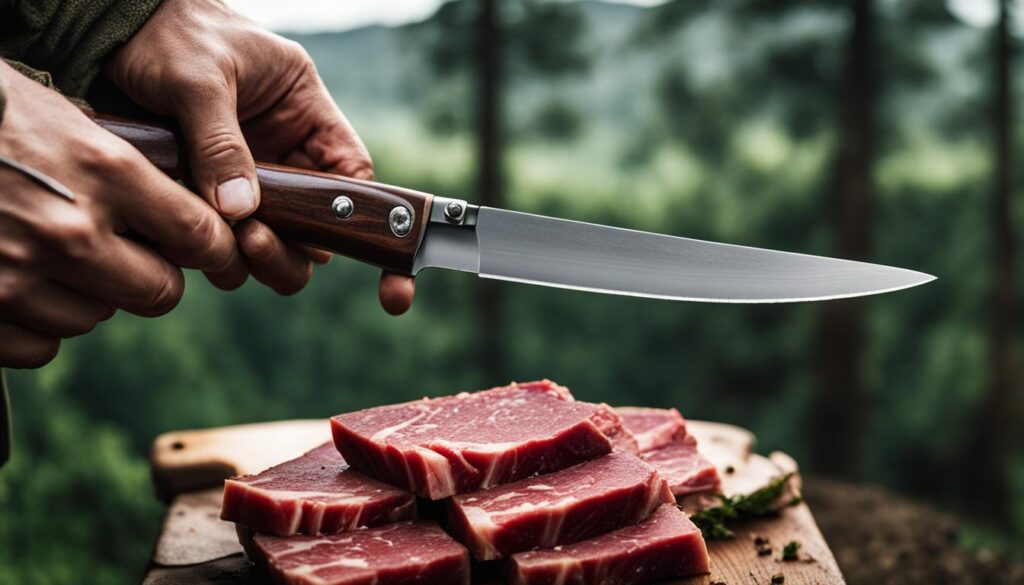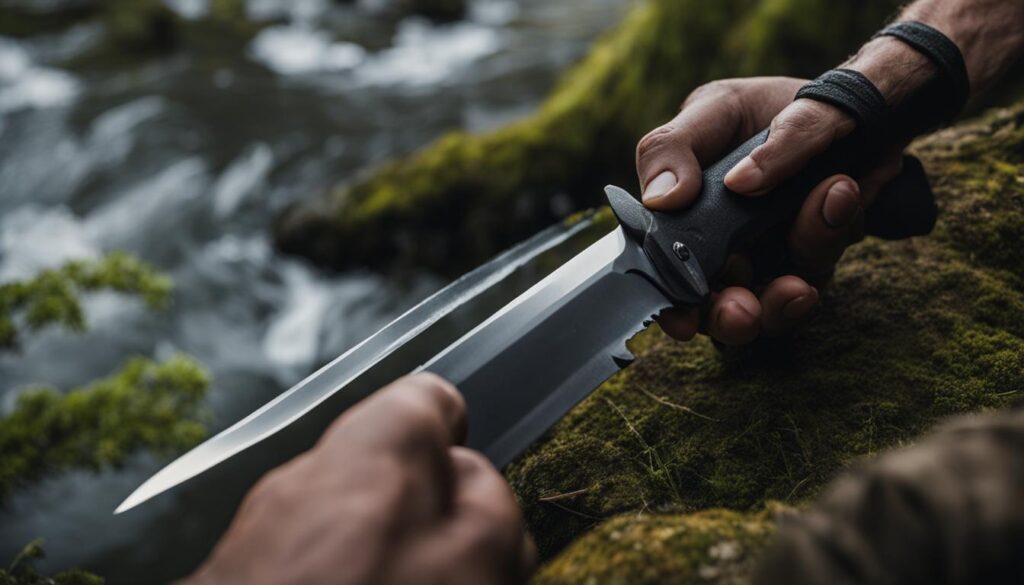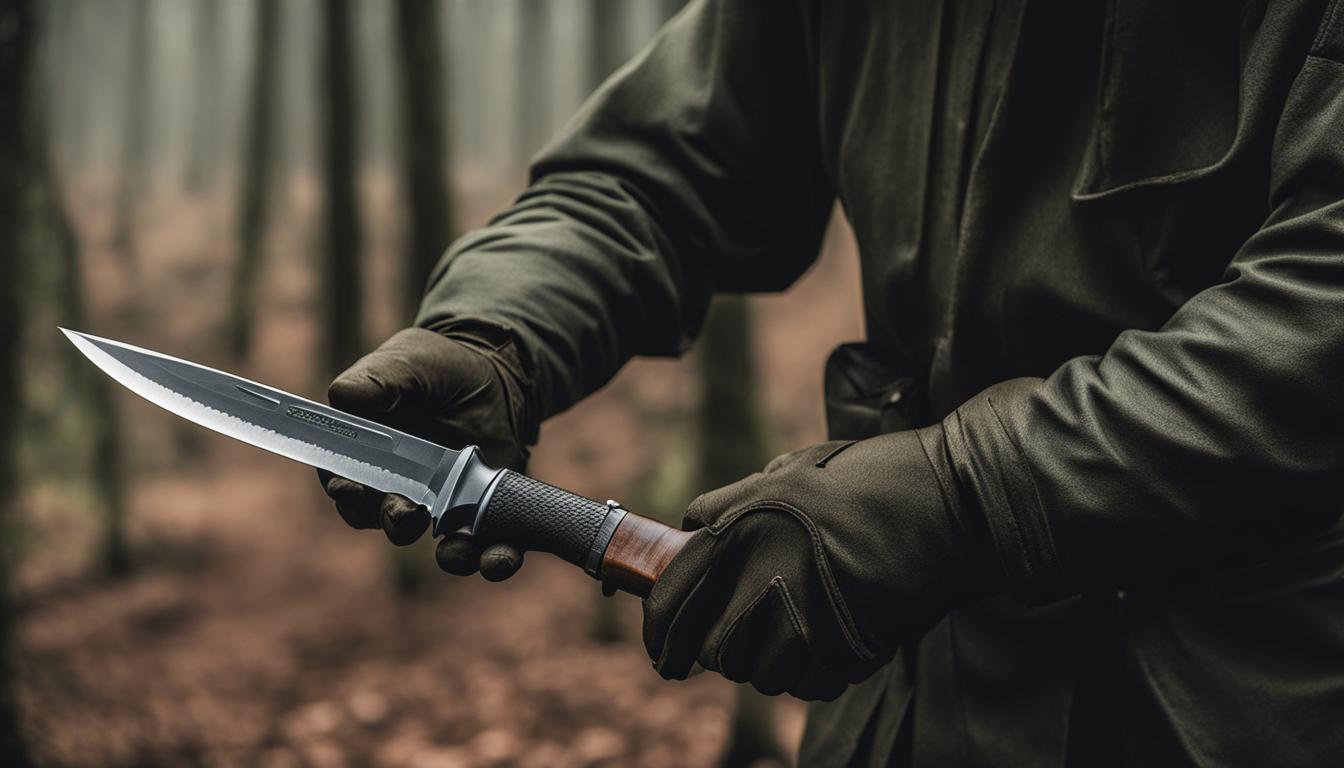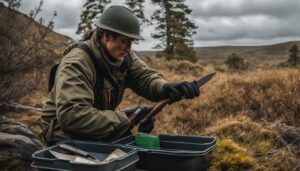Welcome to the definitive guide on mastering knife safety techniques specifically tailored for hunting knives. In this section, we will provide you with comprehensive insights into safe knife handling, training techniques, and tips for maintaining a secure environment during your outdoor adventures.
Key Takeaways:
- Proper knife safety training techniques are essential for safe knife handling during hunting activities.
- Mastering safe knife handling skills ensures a secure environment and minimizes the risk of accidents.
- Continuous practice and adherence to safety guidelines are key to becoming proficient in using hunting knives safely.
- Knife training provides hunters with the necessary knowledge and skills to handle knives effectively and responsibly.
- By following proper knife safety techniques, you can enjoy your hunting experiences while prioritizing safety.
Understanding Different Types of Hunting Knives
When it comes to hunting, having the right tools is essential for success. One of the most important tools in a hunter’s arsenal is a reliable hunting knife. But with so many different types of hunting knives available, it can be overwhelming to choose the right one for your specific needs. In this section, I will provide a comprehensive guide to help you understand the different types of hunting knives and their unique features.
Specialty knives play a crucial role in hunting, offering specific functions that cater to different tasks. Skinning knives, for example, are designed to efficiently remove the skin from game animals. They typically feature a thin, curved blade that allows for precise cuts while minimizing the risk of puncturing the hide. Skinning knives are a must-have for hunters who plan on processing their own game.
Another specialty knife to consider is the gut hook. Gut hooks are equipped with a small, curved blade on the spine of the knife, near the tip. This specialized feature allows hunters to make precise incisions without puncturing vital organs, making the field dressing process much easier and hygienic. Gut hooks are particularly useful for hunters who frequently field dress large game.
In addition to specialty knives, boning knives are also popular among hunters. These knives are designed to easily separate meat from bones, making them ideal for tasks like deboning game animals or filleting fish. Boning knives typically have a thin, flexible blade that allows for precise cuts and maneuverability.
Table: Types of Hunting Knives and their Features
| Type of Hunting Knife | Unique Functions |
|---|---|
| Skinning Knife | Efficiently removes skin from game animals |
| Gut Hook Knife | Makes precise incisions during field dressing |
| Boning Knife | Separates meat from bones with precision |
Understanding the different types of hunting knives available allows you to choose the tool that best suits your hunting needs. Whether you require a knife for skinning, gutting, or boning, it’s important to select a knife with the appropriate features for the task at hand. By investing in a high-quality hunting knife that meets your specific requirements, you’ll ensure a safer and more enjoyable hunting experience.
Knife Maintenance and Care Tips for Safety
Proper maintenance and care are essential for ensuring the longevity and safe use of your hunting knife. By following these knife maintenance tips, you can keep your blade sharp and in optimal condition, minimizing the risk of accidents during your outdoor adventures.
Cleaning Your Knife
Regular cleaning is crucial to prevent any build-up of dirt, grime, or moisture that can corrode the blade or handle of your knife. To clean your hunting knife, use a mild soap or detergent and warm water. Gently scrub the blade and handle, paying close attention to any tight spots or crevices. Rinse thoroughly and dry the knife with a clean cloth to avoid moisture-related issues.
Additionally, it’s important to lubricate your knife periodically to prevent rust and corrosion. Apply a thin layer of oil, specifically designed for knife maintenance, to the blade and handle. This will help protect the metal and ensure smooth operation.
Sharpening Your Knife
A sharp knife is not only more efficient but also safer to use. Dull blades can slip and cause accidents. To maintain a sharp edge, regular sharpening is necessary. There are various sharpening tools available, such as sharpening stones or honing rods. Choose a method that suits your knife and sharpening skills.
When sharpening, remember to follow the angle of the existing edge and use even and consistent strokes. Start with the coarsest grit and gradually move to finer grits for a polished and razor-sharp edge. Remember to test the sharpness of the blade carefully before using it.
Storage Techniques
Proper storage is vital for protecting your hunting knife and preventing accidents. When not in use, store your knife in a sheath or a knife roll specifically designed for safe storage. This will protect the blade from damage and minimize the risk of accidental cuts or punctures. Avoid storing knives in damp or humid environments, as this can lead to rust and corrosion. Instead, choose a cool and dry location for optimal preservation.
By following these knife maintenance and care tips, you can ensure the safety and longevity of your hunting knife. Regular cleaning, sharpening, and proper storage will enhance the performance of your blade, making your outdoor adventures safer and more enjoyable.
| Knife Maintenance and Care Tips: |
|---|
| Clean your knife regularly with mild soap, warm water, and a soft brush. |
| Dry your knife thoroughly after cleaning to prevent moisture-related issues. |
| Lubricate the blade and handle with a knife maintenance oil to prevent rust and corrosion. |
| Sharpen your knife regularly using sharpening stones or honing rods. |
| Follow the existing edge angle and use consistent strokes for effective sharpening. |
| Store your knife in a sheath or knife roll when not in use to prevent accidents. |
| Avoid storing knives in humid environments to prevent rust and corrosion. |
Essential Knife Skills for Safe Handling
In order to handle hunting knives safely and efficiently, it is essential to develop the necessary knife skills. Mastering these skills will not only ensure your safety but also enhance your overall hunting experience. In this section, I will discuss some key knife skills that every hunter should be familiar with.
Knife Grip
The way you hold your knife plays a crucial role in maintaining control and preventing accidents. When gripping your hunting knife, it is important to have a firm but relaxed grip. Avoid gripping the handle too tightly, as this can lead to fatigue and loss of control.
There are several different knife grips that you can use depending on the task at hand. The most common grip is the four-finger grip, where you wrap your hand around the handle with your thumb resting on the spine of the blade. This grip provides good control and stability for most cutting tasks.
Cutting Techniques
Proper cutting techniques are essential for precision and safety when using a hunting knife. One important technique to master is the push cut, where you apply pressure forward while sliding the blade through the material you’re cutting. This technique is ideal for tasks like slicing meat or filleting fish.
Another important cutting technique is the pull cut, where you exert force backward while pulling the blade towards you. This technique is commonly used for tasks like carving meat or skinning game. It is important to practice these techniques to develop the necessary skill and control.

When practicing cutting techniques, always make sure to cut away from your body and keep your fingers away from the blade’s path. Maintaining a safe distance between your hands and the blade is crucial to avoid accidental cuts or injuries.
Filleting Fish and Carving Meat
Lastly, let’s talk about two specific knife skills: filleting fish and carving meat. Filleting a fish requires precision and finesse to remove the meat from the bones without wasting any of it. A flexible fillet knife is typically used for this task, as it allows for greater control and maneuverability.
Carving meat, on the other hand, requires a different set of skills. When carving meat, it is important to make smooth and even slices to ensure tenderness and presentation. A sturdy carving knife with a long, thin blade is the ideal tool for this task.
Remember, mastering these essential knife skills takes practice, patience, and a focus on safety. By developing these skills, you will not only improve your efficiency in the field but also ensure your own well-being and the longevity of your hunting knives.
Understanding Knife Laws and Regulations
When it comes to hunting knives, understanding the legalities and regulations surrounding their use is essential. Different regions and countries have varying laws regarding the possession, transportation, and use of knives, including hunting knives. In this section, we will explore the key aspects of knife laws and legal restrictions, as well as provide guidance on traveling with knives while staying within the boundaries of the law.
Regional and National Laws
Knife laws can differ significantly from one region to another, making it crucial for hunters to familiarize themselves with the specific regulations of their area. Some states or countries may have restrictions on blade lengths, blade types, or even the carrying of certain types of knives in public. It is important to research and understand the laws in your jurisdiction to avoid any legal repercussions.
In the United States, for example, knife laws are determined at both the federal and state levels. Federal law governs knife possession and transportation on federal lands, such as national parks, while individual states have their own laws that apply within their boundaries. It is advisable to consult local law enforcement agencies or legal professionals to obtain accurate and up-to-date information on the knife laws in your area.
Traveling with Knives
For hunters who plan to travel with their knives, whether domestically or internationally, it is essential to be aware of the laws and regulations that apply during transportation. Different countries have varying rules regarding the possession and importation of knives, and failure to comply with these regulations can result in confiscation or legal consequences.
Prior to traveling, research the knife laws of your destination country and ensure that your knives meet their requirements. Some countries may have specific documentation or permits that you need to obtain in advance. It is also important to pack your knives securely and follow any guidelines provided by transportation authorities to prevent accidental injuries and ensure a smooth travel experience.
Knife Safety Tips for Responsible Use
When it comes to knife safety, it is crucial to promote responsible use and educate individuals, especially children, about the ethical practices surrounding knives. By equipping them with the knowledge and skills necessary for safe knife handling, we can ensure a secure and enjoyable outdoor experience for everyone.
One of the fundamental aspects of knife safety is teaching children the proper way to handle knives. It is essential to educate them on the potential dangers associated with knives and instill responsible habits from an early age. Emphasize the importance of always using a knife under adult supervision and teach them the correct techniques for grip, cutting, and handling.
Aside from educating children, promoting responsible use of knives involves setting a good example and adhering to safety guidelines ourselves. Always emphasize the importance of using a knife for its intended purpose and avoiding reckless behavior. By practicing ethical practices, we not only ensure our own safety but also contribute to a culture of responsible knife use in the hunting community.
Furthermore, it is crucial to emphasize the significance of proper storage and transportation of knives. When not in use, knives should be securely stored in a sheath or protective case to prevent accidental injuries. Additionally, when traveling with knives, be familiar with the local laws and regulations to ensure compliance and avoid any legal issues.
| Knife Safety Tips for Responsible Use |
|---|
| 1. Educate children about the proper way to handle knives. |
| 2. Set a good example by practicing responsible knife use. |
| 3. Emphasize the importance of proper storage and transportation. |
| 4. Stay informed about local knife laws and regulations. |


“Responsible knife use starts with education and setting a positive example. By teaching children and beginners proper knife handling techniques and promoting ethical practices, we can ensure the safety of ourselves and others in the hunting community.” – KnifeSafetyExpert
Conclusion: Ensuring Safety and Proficiency in Knife Handling
Throughout this definitive guide on mastering knife safety techniques for hunting knives, I have provided comprehensive information and tips to ensure safe knife handling. By following these guidelines, you can minimize the risk of accidents and injuries while maximizing your proficiency in using hunting knives.
Knife safety training techniques are crucial for any hunter or outdoor enthusiast. By learning proper knife grip, cutting techniques, and essential skills like filleting fish or carving meat, you can handle knives safely and effectively. Remember, practice is key to mastering these skills, so dedicate time to refine your technique.
Safe knife handling goes beyond the technicalities. It also involves understanding knife laws and regulations to ensure compliance when using and traveling with hunting knives. Educating children and beginners about knife safety is equally important for fostering responsible use and ethical practices.
To become proficient in knife handling, prioritize proper knife maintenance and care. Regularly clean and store your knives correctly, and sharpen them when necessary. A sharp blade not only improves performance but also reduces the risk of accidents caused by dull knives.
By combining knowledge, practice, and adherence to safety guidelines, you can develop a high level of skill and confidence in using hunting knives safely. Remember, prioritizing safety is the key to an enjoyable and successful outdoor adventure.
FAQ
What are some important knife safety training techniques for hunting knives?
Some important knife safety training techniques for hunting knives include always keeping the knife pointed away from yourself and others, using a firm and controlled grip, and never leaving the knife unattended or within reach of children.
What are the different types of hunting knives available on the market?
The different types of hunting knives available on the market include specialty knives like skinning knives, gut hooks, and boning knives. Each knife has unique features and functions that cater to specific hunting needs.
How should I maintain and care for my hunting knife to ensure safety?
To maintain and care for your hunting knife, it is important to clean and dry it after each use, store it in a sheath or protective cover, and regularly sharpen the blade. Proper maintenance will help keep the knife in optimal condition and reduce the risk of accidents.
What are some essential knife skills for safe handling?
Some essential knife skills for safe handling include proper knife grip, learning different cutting techniques, and acquiring specific skills for tasks like filleting fish and carving meat. Practicing these skills will enable you to handle knives safely and efficiently.
What are the laws and regulations concerning hunting knives?
Laws and regulations concerning hunting knives vary by region and country. It is important to research and understand the legal restrictions in your area, including any permits or licenses required for hunting with a knife. Additionally, guidelines for traveling with knives domestically and internationally should be followed to ensure compliance with the law.
What are some general knife safety tips for responsible use?
Some general knife safety tips for responsible use include always treating the knife with respect, educating children and beginners about knife safety, promoting ethical practices such as not using a knife to harm animals unnecessarily, and practicing caution when using knives in outdoor environments.





